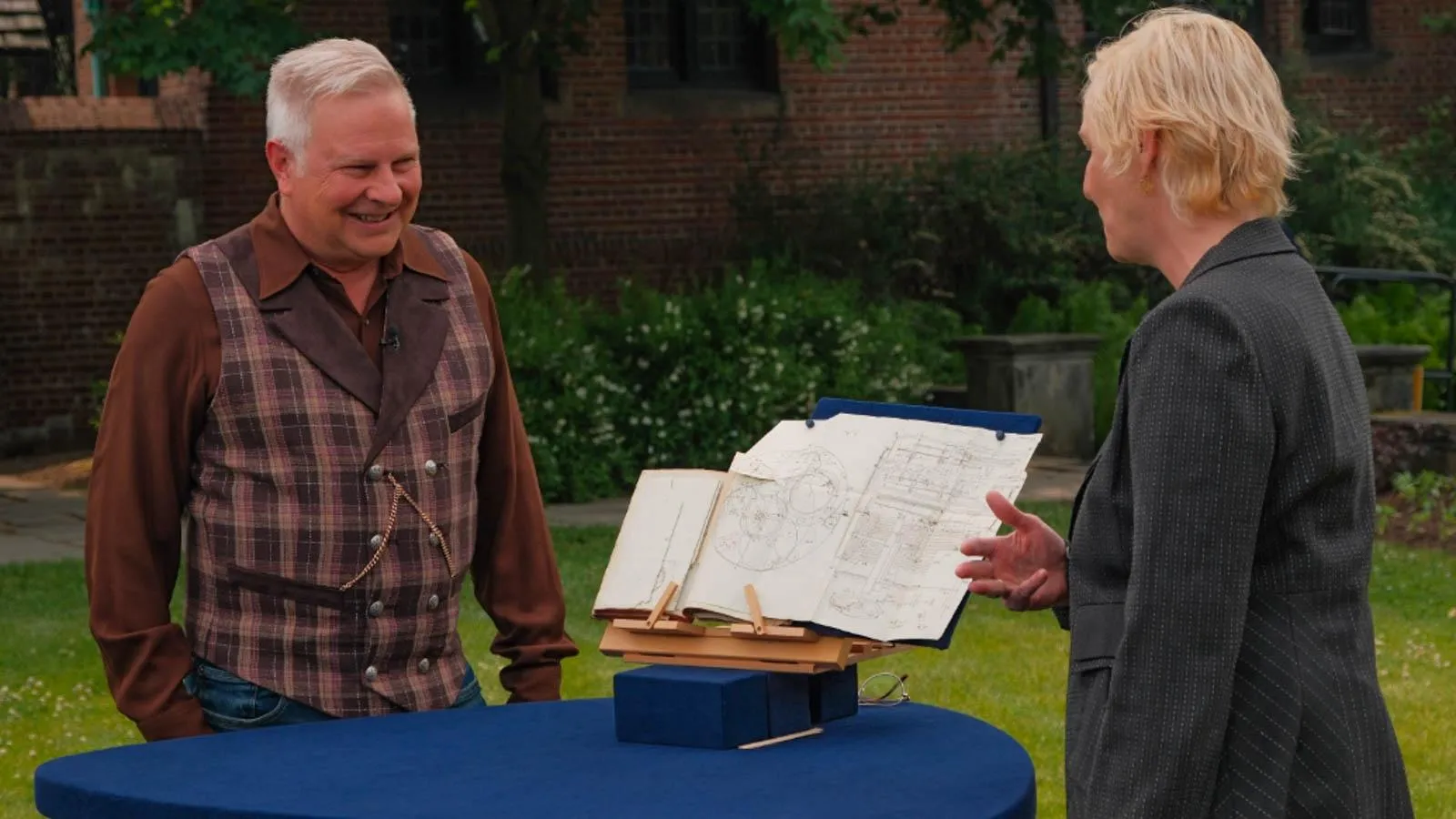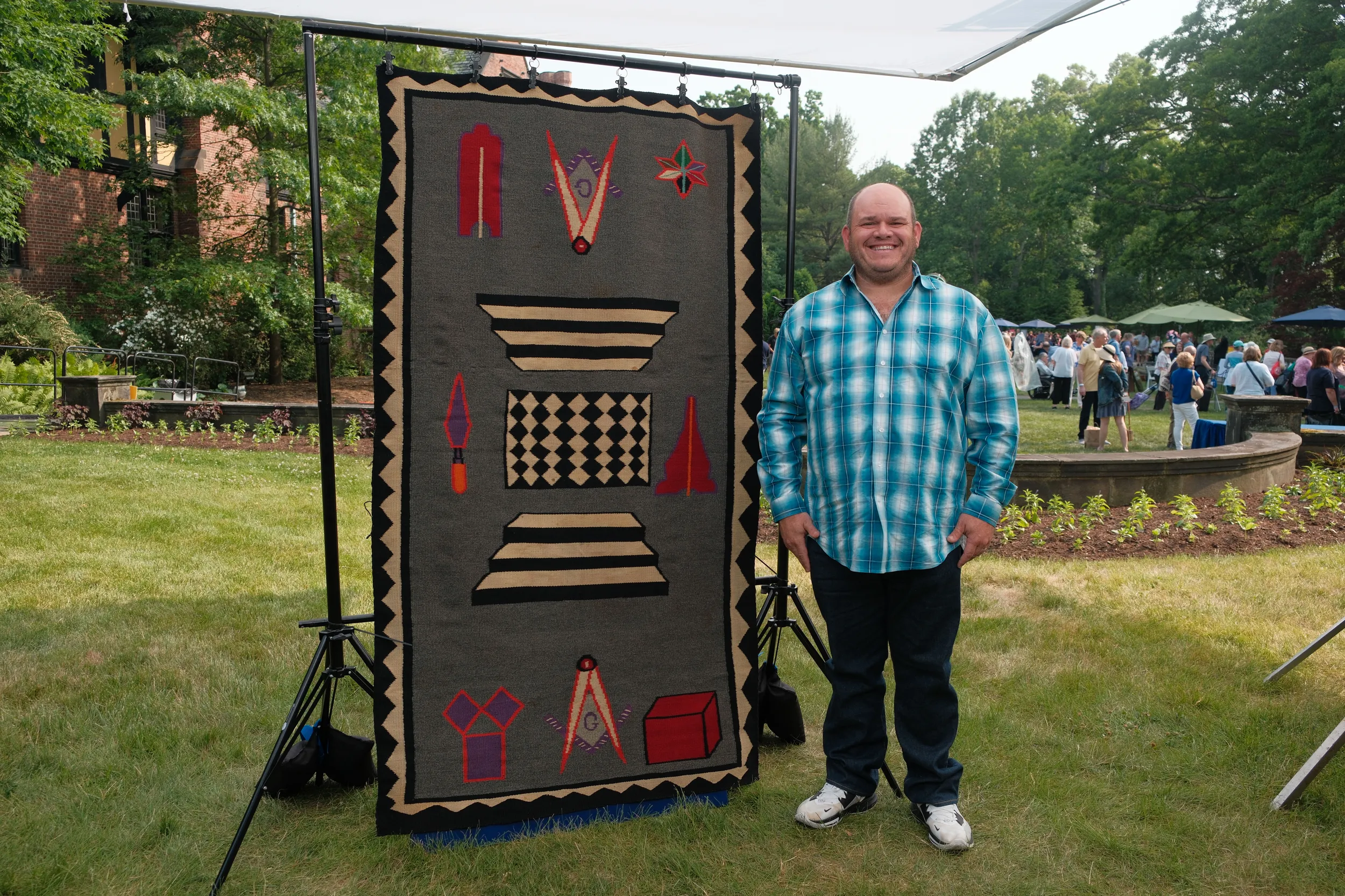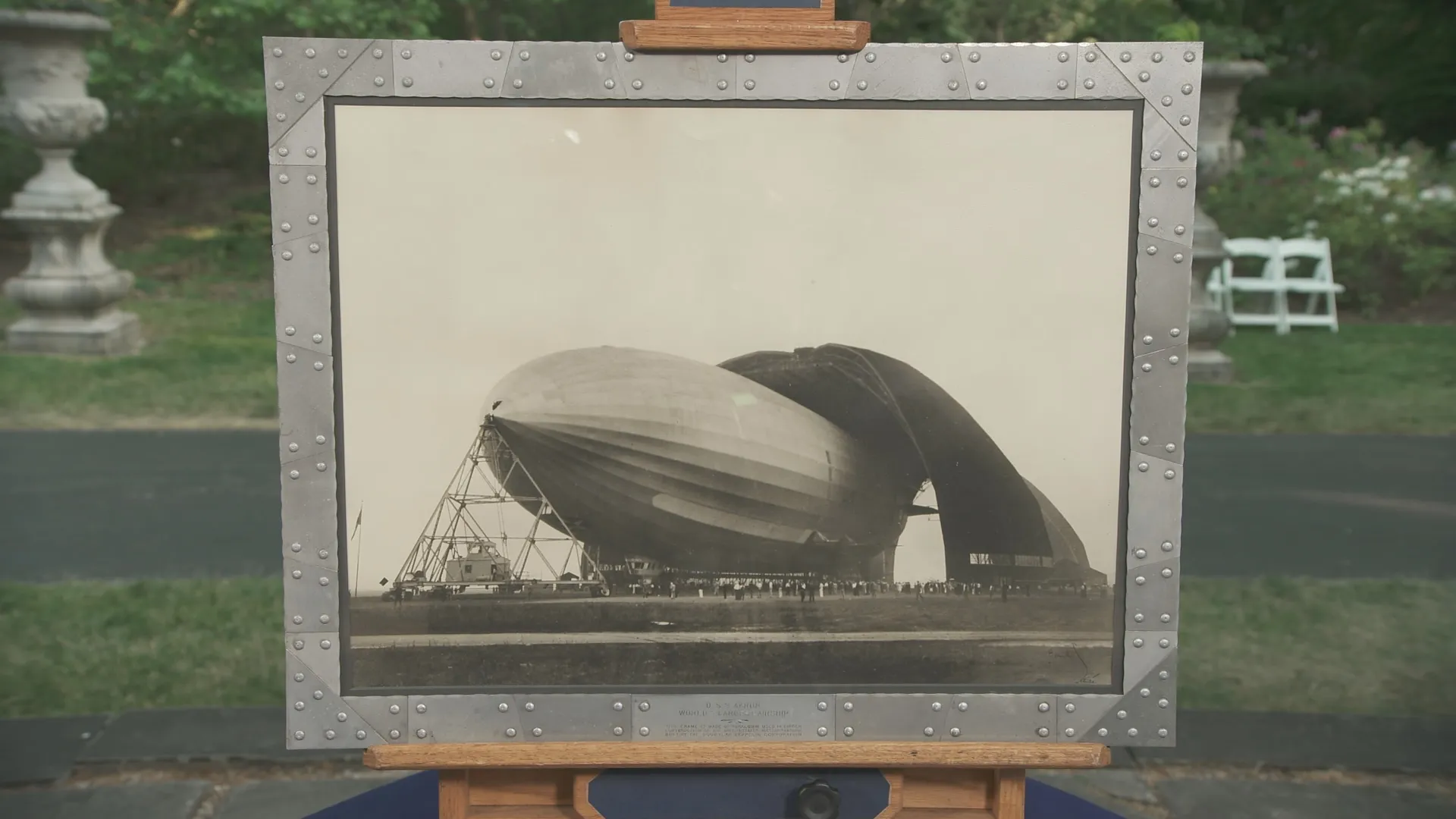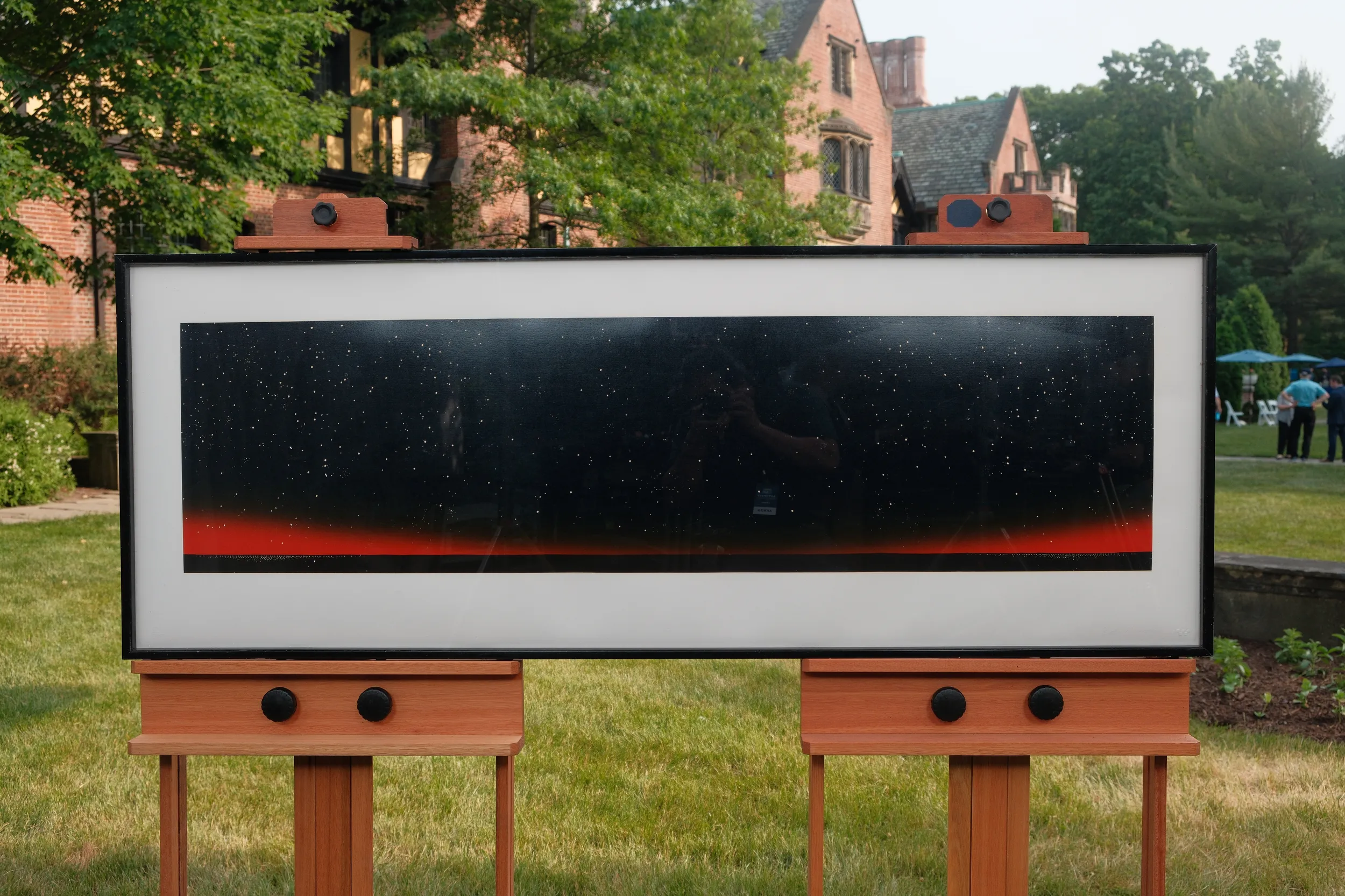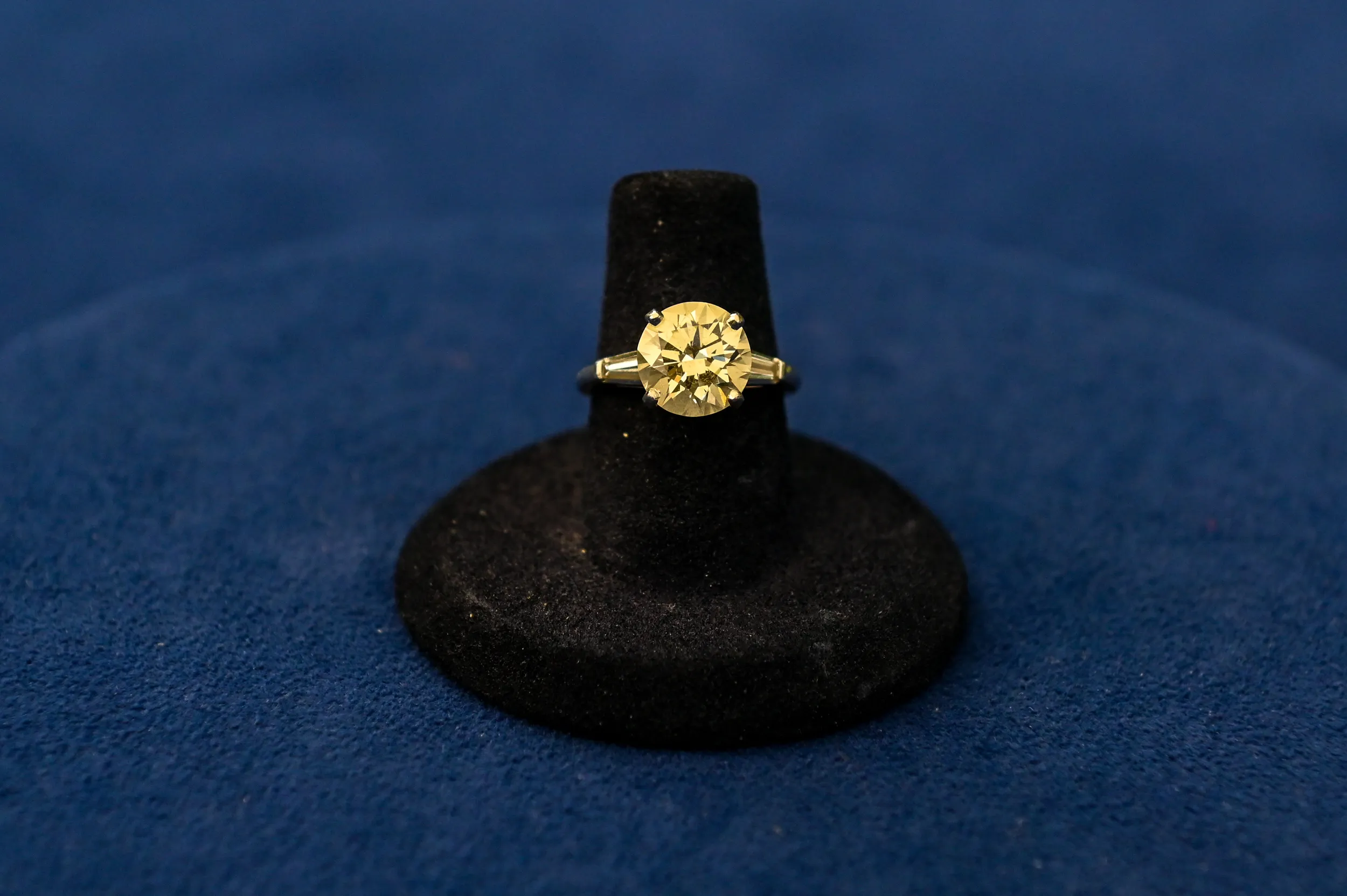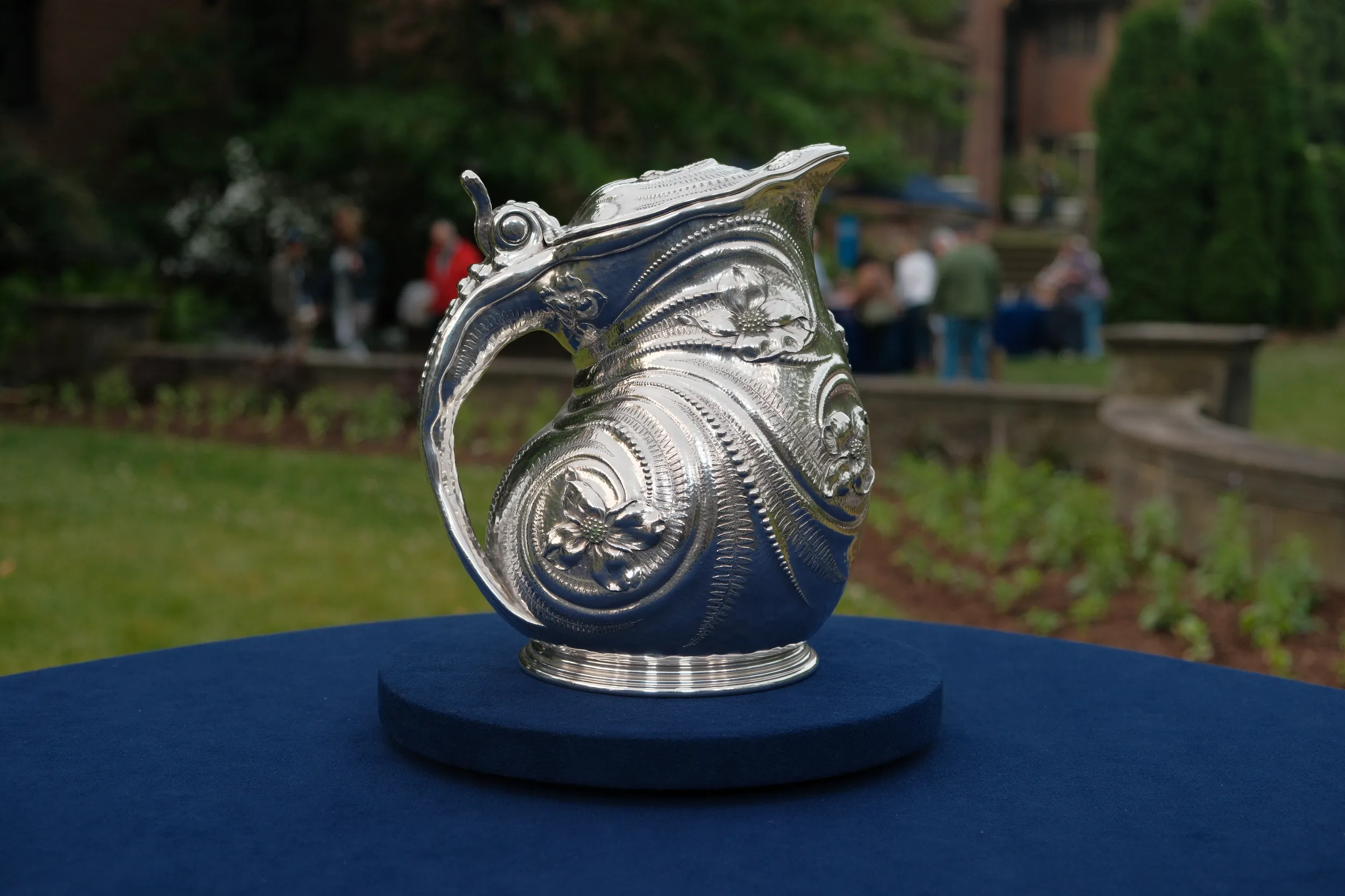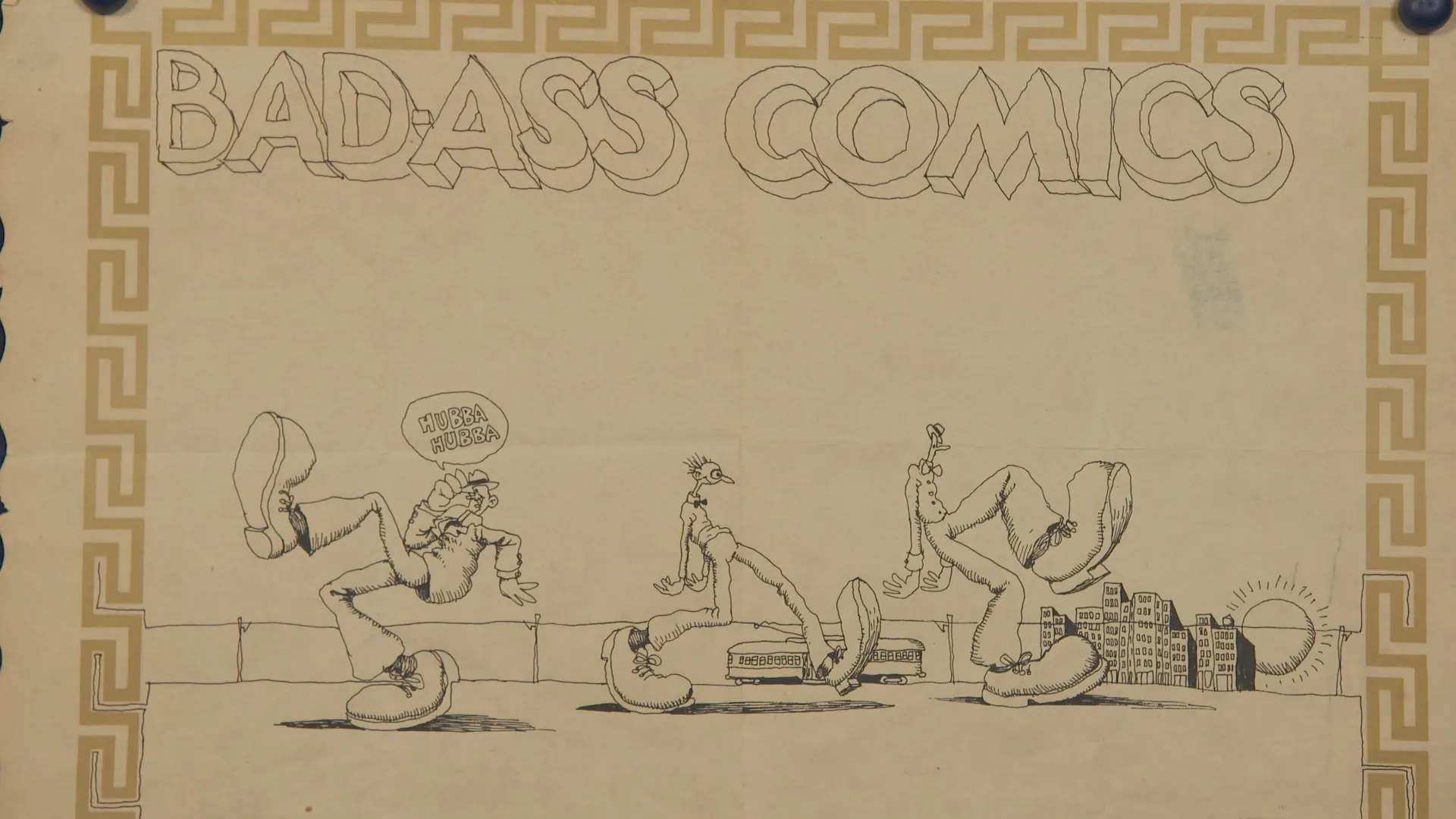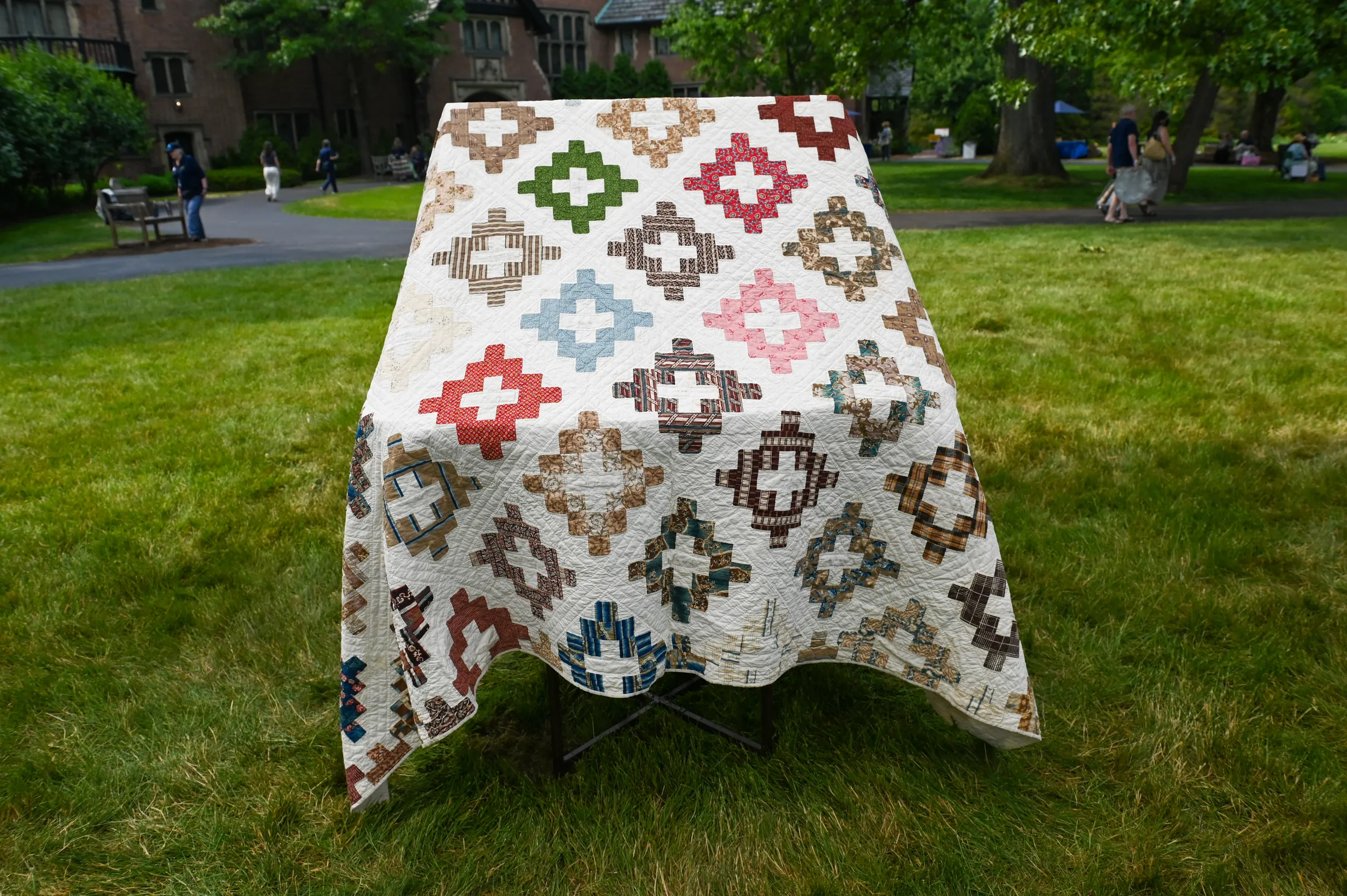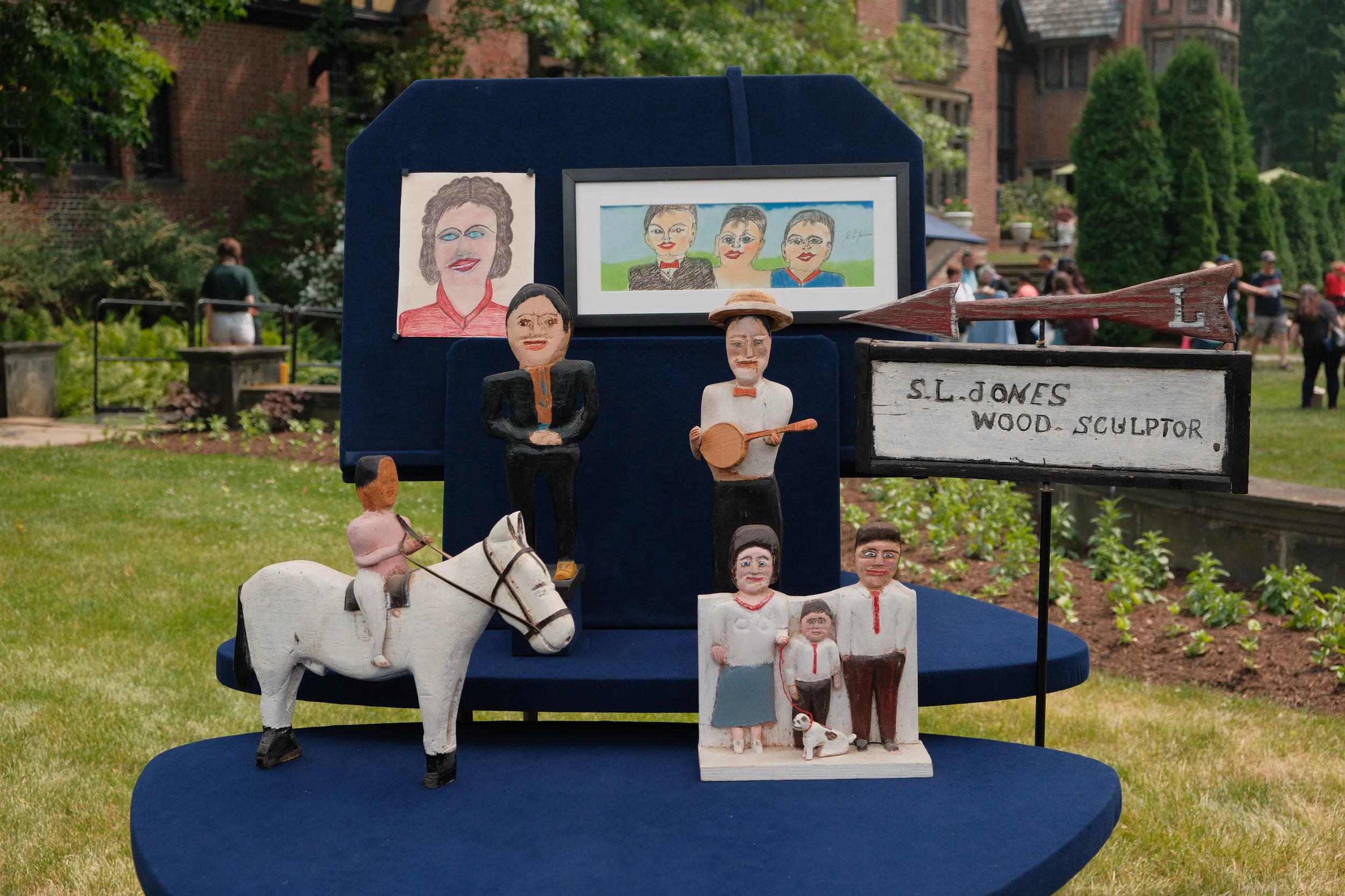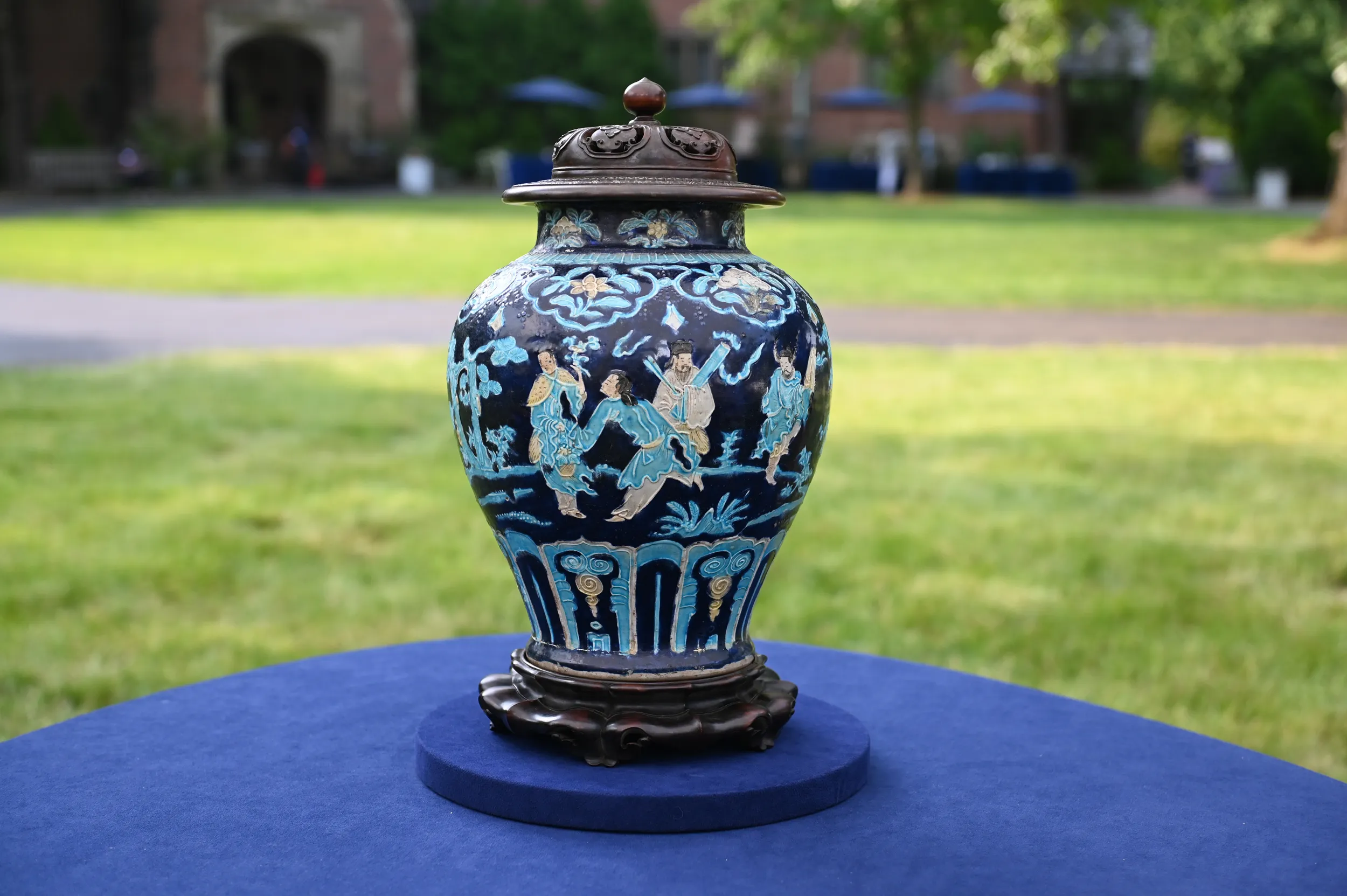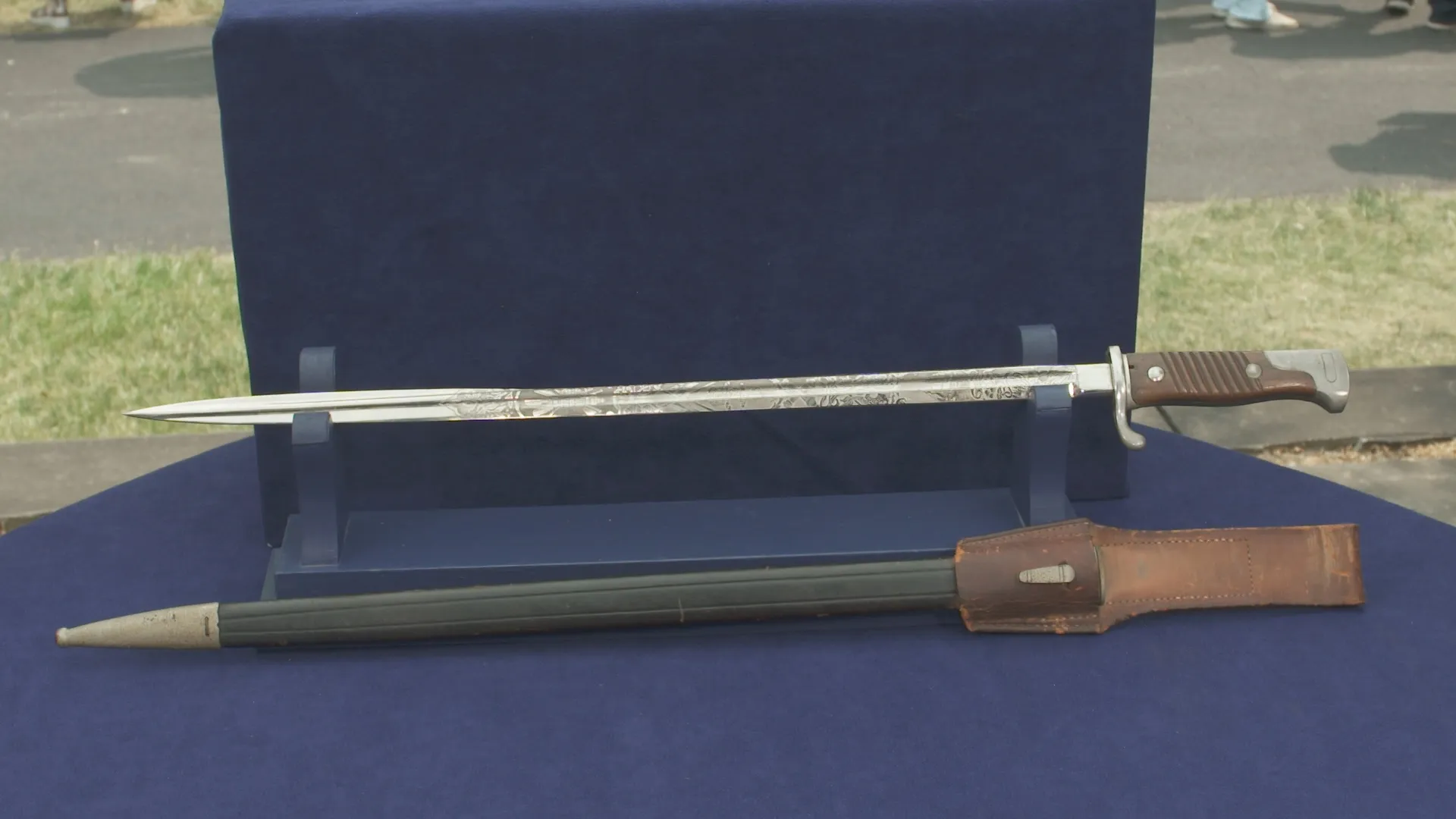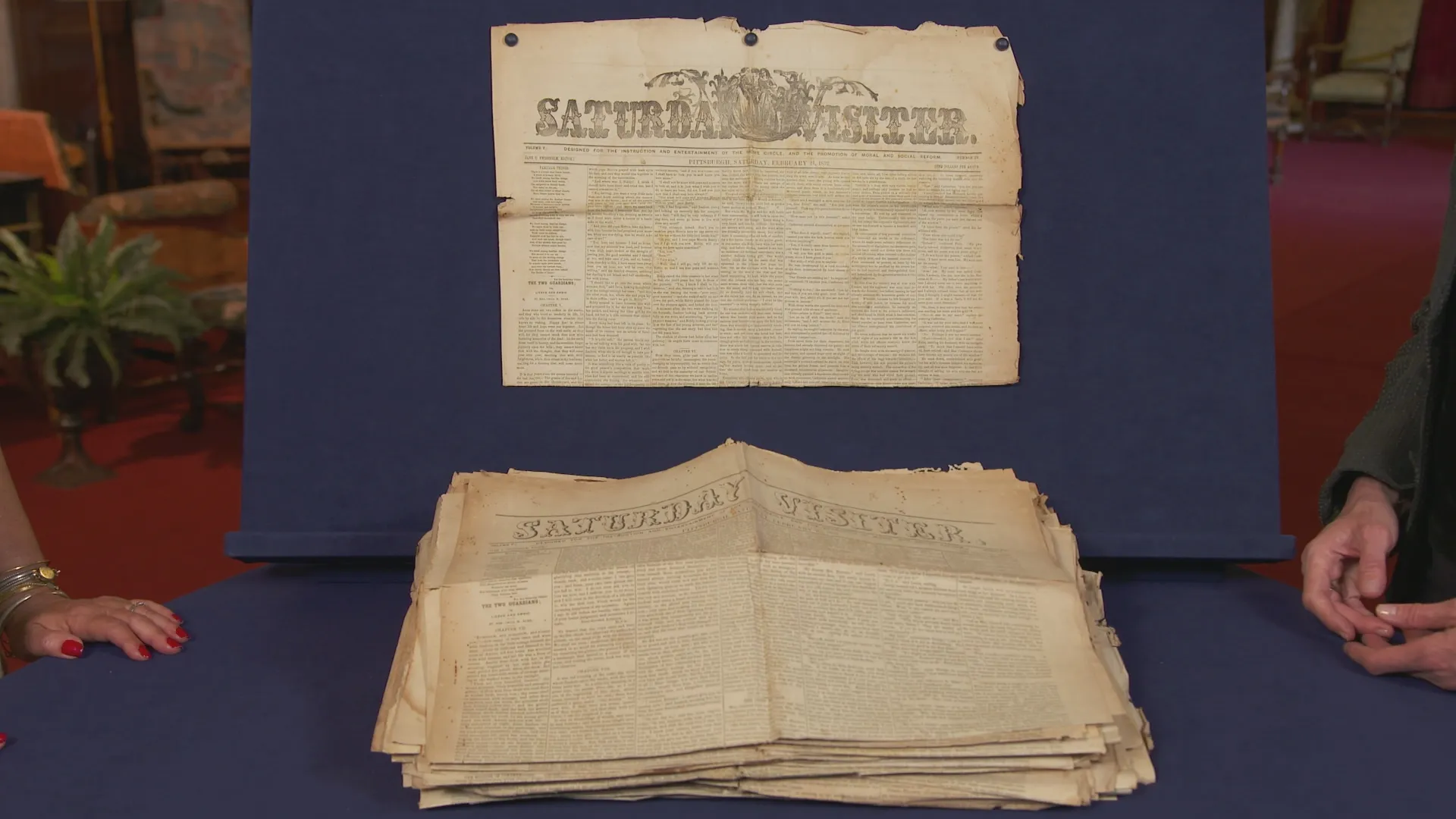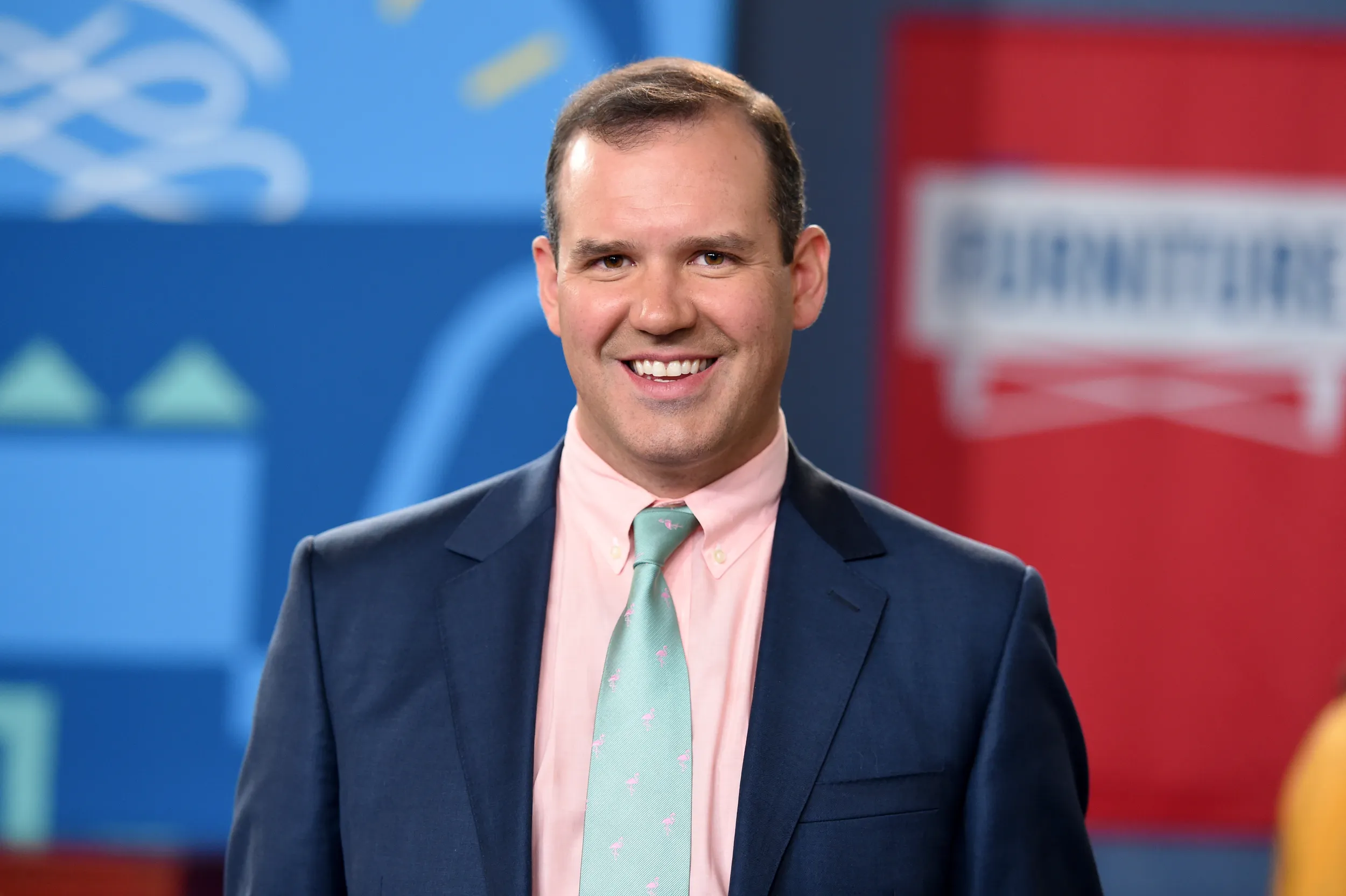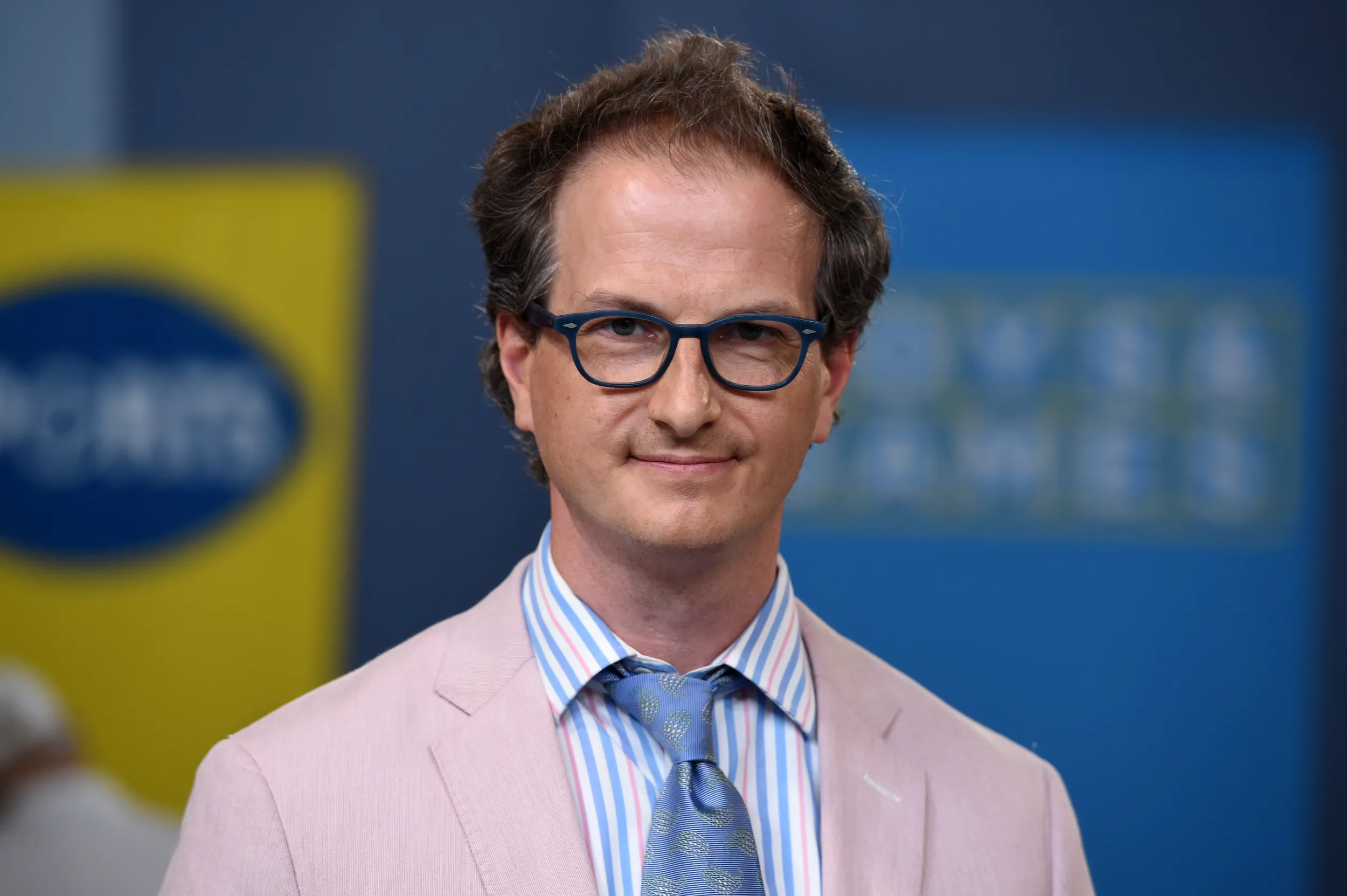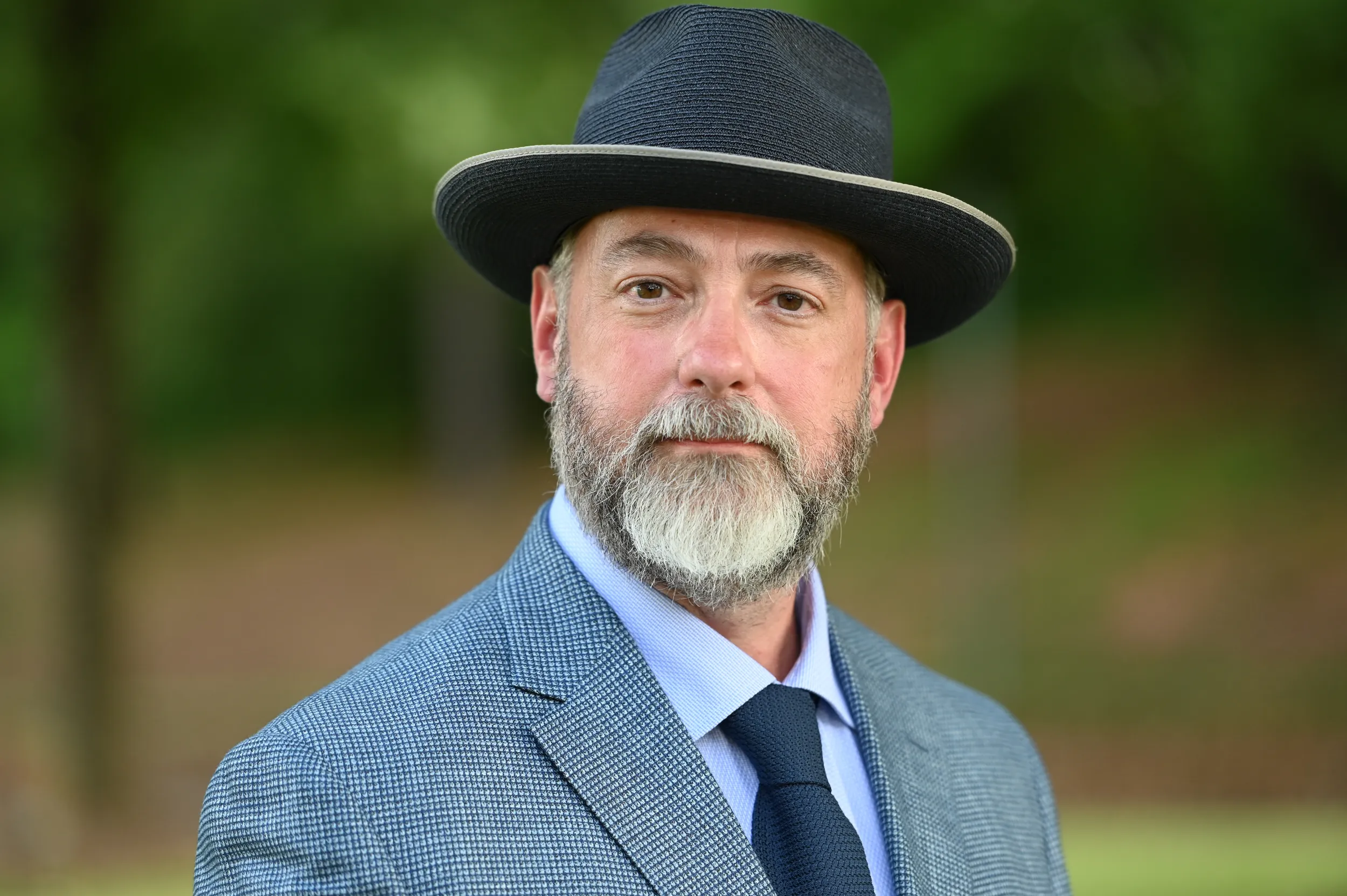HOST: ANTIQUES ROADSHOW is checking out treasures in Akron, Ohio.
APPRAISER: This is the last thing that I expected to see come tumbling out of
that scabbard.
GUEST 1: Wow. (laughs)
GUEST 2: Oh, my gosh. (chuckles) (inhales sharply)
HOST: If you're in Akron, Stan Hywet Hall and Gardens is a popular attraction. “Stan hywet” is Old English for "stone quarry," after a natural feature on the original 1,500-acre property. Today, 70 acres comprise the grounds, along with five historic buildings and ten fully restored historic gardens. Stan Hywet is an American country estate built during the Industrial Age, completed in 1915. The cost of construction for the hall, including interior decorating and four service buildings, was around $900,000. That's over $27 million in 2024. What did almost a million dollars get you back in 1915? A 64,500-square-foot Tudor Revival-style mansion with 65 rooms, 18 bedrooms, 23 bathrooms, 23 fireplaces, a great hall, a glamorous music room, and a tower with beautiful views of some of the property's gardens. Not too shabby. The beloved home of the Seiberling family is now an historic house museum and garden.
HOST: What treasures have our guests brought to ROADSHOW here at Stan Hywet today?
APPRAISER: These are fabulous. Just imagine if you're a musclehead, anybody into
automobilia.
GUEST: Yeah.
APPRAISER: This is meant for the man cave in the garage.
GUEST: Absolutely.
GUEST: This was, I believe, my great-grandmother's ring. She was born in the 1870s.
APPRAISER: The diamonds are each about one carat, and it's a beautiful twin-stone ring. And what I love about it is that beautiful strap work, all of those details on the shoulders. It's gorgeous. It's just gorgeous.
GUEST: Yeah, I think so.
APPRAISER: No marks on the ring to tell where it's from. I would guess it's probably New York manufacture.
GUEST: Okay.
APPRAISER: There was some very high-quality jewelry-making in the period...
GUEST: Mm-hmm.
APPRAISER: ...which is 1920s.
GUEST: 1920s. That makes sense.
APPRAISER: 1920s.
GUEST: Okay.
APPRAISER: In an auction setting, these rings are so, so desirable.
GUEST: Are they?
APPRAISER: I would probably say we would easily get between $6,000 and $10,000 for it at auction.
GUEST: Oh, wow, that's lovely.
APPRAISER: If you had to insure it…
GUEST: I'm...
APPRAISER: ...I would easily want to insure this for $20,000 to $30,000.
GUEST: Okay-- oh, wow.
APPRAISER: All right?
GUEST: Thank you! Awesome. I'm delighted to learn more about it. That's really why I came, and I'm so pleased.
GUEST: This is a Masonic Navajo Indian rug. It belonged to my great-grandfather. And the story goes, around 1930, he found himself in New Mexico, and he did some work for fellow Masons there. And they showed him some type of rug similar to this. And they said, "If you go up to "the Navajo Indian reservation near Gallup,
they make 'em up there." So when he found himself near Gallup, he said, "I want to get one of those Masonic Navajo rugs made," and they said, "We'll do it." And because he was a construction worker, he put in a linoleum flooring in some of their buildings on the reservation in trade for this rug. He passed it on to my grandmother and grandfather, who were also part of the Masonic Lodge. Then they gave it to my dad, who is a Mason. And then when I became a Mason, my father gave it to me, and I've had it for about 20 years.
APPRAISER: I, I'm really curious. Tell me a little bit about the Masons.
GUEST: Well, the Masons are an organization of men. They believe in God,
and they believe in order to serve God, you're supposed to have a positive impact
on your family and on your community and on the world. But before you can do that, you have to make yourself a better man on the inside. And so that's kind of
the general idea.
APPRAISER: Beautiful. Well, you know what I love about that is that those doctrines of altruism, they tie into family and community.
GUEST: Mm-hmm.
APPRAISER: And so, so much of those values are really part of the Navajo values. There's some things that really excited me when I fir– you brought this in, I looked at it. I thought, "Wow, that's a Navajo rug." And then when I hear that this came from my hometown I was born in, I was really excited. I thought… I'm from Gallup, New Mexico. I was born and raised there.
GUEST: Right.
APPRAISER: And I'm half-Navajo. And so when I look at this, I think it called out, to say, like, "I want to, I, I want to not only appraise this, but I want to learn from this." This, what looks like, um, calipers? What is…
GUEST: It's called the Square and Compasses. The G in the middle stands for God. And the idea is, with the square, it's kind of like a ruler. You use it to make perfect 90-degree angles. You're supposed to live your life justly and fairly and squarely with others. And then the compasses, you remember from your middle school and
high school geometry class, you would use it to make a perfect circle.
APPRAISER: Right.
GUEST: Those things that are pleasing to God should remain in the circle. And those things that aren't fruitful for your fellow man should be outside the circle.
APPRAISER: This Navajo weaving was woven with commercial yarn, which came from Germantown, Pennsylvania.
GUEST: Okay.
APPRAISER: And in the regular world, we call this a Navajo pictorial.
GUEST: Okay.
APPRAISER: And I find the story behind this as interesting– it, it empowers the weaving. It creates some dynamic element.
GUEST: Yes.
APPRAISER: I think it's a fantastic example of the connection between people,
and how we can actually have, share...
GUEST: Yeah.
APPRAISER: ...the same doctrines of these values. There are some other
similar examples of Masonic weavings. I'm thinking a, a value that I would put on this in a, in a retail type of situation would be about $7,500.
GUEST: Wow.
APPRAISER: $7,500.
GUEST: (chuckling) Dad and Grandpa will be, uh, interested to know that. They've been wondering that for a while.
APPRAISER: For an insurance, replacement value, I would say that, that a weaving like this would be around $10,000 to insure it.
GUEST: But, uh, for the family, it's the family story, and it gets brought out all the time, and new people get to learn the story. And now that you've added to it, I have more I can tell them.
APPRAISER: Fantastic.
HOST: Although Stan Hywet Hall looked like a very old house that had stood for centuries, it had every modern convenience of its time. Here in the library, can you spot the telephone? Did you guess it was in this ornate case? This was a clever way to have the latest technology without sacrificing the authentic aesthetic of the Seiberlings' living space.
GUEST: This is a,a family picture that we've had for two generations now. And it was given to my dad's dad at the christening of the Akron airship in August of 1931
at the air dock here in Akron. My grandfather was an en, an executive at Goodyear.
That's why he was given this, to commemorate that.
APPRAISER: So this is a photograph by Margaret Bourke-White. Margaret Bourke-White was a pioneer in industrial photography. She was born in New York, went to Cornell, and then moved to Cleveland to be closer to her mother.
GUEST: Mm.
APPRAISER: And it was in Cleveland that she opened her first studio and it inspired her to be an industrial photographer. This Margaret Bourke-White's iconic photograph of the U.S.S. Akron in its original presentation frame. It's made of duralumin, which was the same lightweight aluminum alloy that was used to build the airship that was built by the Goodyear Zeppelin Company for the U.S. Navy. It was lightweight and strong and perfect for the armature of the zeppelin.
GUEST: Mm-hmm.
APPRAISER: And these works were given as gifts to employees of the zeppelin company. One of the many strengths of Margaret Bourke-White was to take these large industrial objects and humanize them to create fine art. And this is a perfect example of that. We don't know how many are out there and we don't know how many they gifted. Having said that, we do see them from time to time. But what's really difficult is to find prints in excellent condition. Yours has a few minor condition issues. Most notably, in the front lower region, you'll see some type of--
almost looks like a repaired tear, but overall, it's in very good condition. I would price this for auction at $4,000 to $6,000.
GUEST: (sighing) Oh, wow. (inhales) (chuckling) That's wonderful, that's remarkable. Thank you.
APPRAISER: Other examples of this print that are in excellent condition have sold up to $15,000.
GUEST: I don't know who made it, what it was used for, or when it was used. Hopefully today, we'll find out who my little friend is.
GUEST: It's a poster of Marilyn Monroe that was in my house when I moved in in 1986. It was up on a rafter. I unrolled it. I had three young girls, so I rolled it back up and put it into a, uh, a mailing tube, and left it there until two years ago. (chuckles) And it was in this issue, 1953, issue of Popular Science. Marilyn Monroe pin-up, and it was, uh, two dollars. (laughs) 1953.
GUEST: My husband used to work for a moving company in Boston, and someone just gifted it to him.
APPRAISER: Wow.
GUEST: That… Someone he was moving.
APPRAISER: Have you had it on your wall for a long time?
GUEST: Yes, it's been on my wall for, like, 20 years.
APPRAISER: Okay-- do you have an idea who the artist is?
GUEST: Ed "Roo-sha," I believe? I looked him up, but I don't know much about him.
APPRAISER: Well, I was really excited when I saw you bring this to the table.
GUEST: Mm-hmm.
APPRAISER: Because this is very, uh, much an Ed "Roo-shay" kind of print. Ed Ruscha was born in 1937, and he continues to make art today. He's a California artist...
GUEST: Mm-hmm.
APPRAISER: ...known for his work in Los Angeles. This is a big screen print. This is a five-foot by 24-inch-wide print.
GUEST: Mm-hmm.
APPRAISER: I could tell it was Ed Ruscha, but I hadn't actually seen this print before.
GUEST: Oh, really?
APPRAISER: It is an original screen print, and it's hard to see, but it is signed and dated 1980. As well, there's a, what we call a blind stamp. It's like a little emboss pressing, and that's usually the mark of the printer or the publisher. The artist published this print himself.
GUEST: Mm-hmm.
APPRAISER: So, I don't know if this is his embossing or the printer. Over by you, lower left, is the number. The edition is 27 of 35. Ed Ruscha is known for his images of Los Angeles and California.
GUEST: Mm-hmm.
APPRAISER: He really epitomizes what we would call California cool. Very influential artist. Part of the Pop movement in Los Angeles. He was very influenced by signs and travel, car travel. He's probably best known for his Standard Station, which is also a nice, big, long, panoramic image. In most of his images, there aren't many people. It's really about signage and the landscape. He moved to Los Angeles. He grew up in Oklahoma and traveled Route 66.
GUEST: Mm-hmm.
APPRAISER: You gave me the title, you knew the title.
GUEST: Yes, I found the title online. Two Similar Cities.
APPRAISER: Exactly. So you can see the two cities lit up at night. He's a really important American artist. His works are in every major museum collection. And this is a scarce print. It's an edition of 35. It really hasn't come to auction very often.
GUEST: Oh, really?
APPRAISER: I would give a conservative estimate at auction at $15,000 to $25,000.
GUEST: Wow. Nice. (chuckles)
APPRAISER: Yeah. It…
GUEST: Well. That's a surprise. (laughs)
APPRAISER: I think it could do a, as well, and if not more. The last time it came to auction was five years ago.
GUEST: My grandmother got married to my grandfather in 1935. My grandfather didn't have a lot of money, and it was just right in the heart of the Great Depression, and he gave her a very, very small diamond in a large ring. She always vowed that she would get a larger diamond. Uh, her father passed, and she had a bit of money. She saved up money for years, and she went to a jeweler in New York City and wanted the biggest diamond that she could possibly get for the amount of money that she had. That's w, what it is. What she told me was, she was terribly embarrassed by her wedding ring. The ring was so small, she didn't want to show her friends. So she ended up getting this, but she never showed this to anyone, either.
APPRAISER: (laughs)
GUEST: So she was a very modest person, a wonderful person, and one of my sheroes in life.
APPRAISER: When did she get this stone?
GUEST: She got this sometime between the late 1950s and the early 1960s. I got it approximately 1996. After she gave it to me, she explained that the setting wasn't as important to her as the stone. She wanted to have a nice stone.
APPRAISER: And your grandfather was still alive at that time?
GUEST: Oh, yeah.
APPRAISER: Was he aware of this undertaking at that point?
GUEST: I know when my grandmother confided to me about her wedding ring
being too small, he wasn't in the room, and, and, you know, as far as I know,
he never knew about it. She kept it in, in, in a, in a little bag, two bags. And, uh, that's the way I kept it, with a safety pin. She had, everything had a safety pin on it. It's only been worn twice in the past 25 years.
APPRAISER: So you have no idea what she spent in the '50s or '60s when she commissioned the ring.
GUEST: It was, like, maybe a couple of thousand dollars? I don't know. But I know it was her one big lifetime splurge. She loved the ROADSHOW.
APPRAISER: Mm-hmm.
GUEST: (murmurs) And I love the ROADSHOW, and we literally used to watch it together for years. And she was a big fan of, you know, Berj, uh, Zavian.
APPRAISER: Well, you provided a great segue, because we double-checked that this is, in fact, a diamond, using a machine that's been nicknamed the Berjometer,
after Berj Zavian, so it is, in fact, a diamond.
GUEST: Okay.
APPRAISER: We, you know, I consulted with my colleagues. We looked at the size.
It's around three-and-a-half carats, a little bit more. One would have to take it out of the mount in order to be precise about the weight. The mount is a fairly straightforward mount from that period. It's a good-quality platinum mount. So it's a nice stone. It's got a little color to it, but not a lot. We estimate the color as, like, a K or an L color. It's a pretty clean stone, so it's probably an S.I.1, S.I.2, something like that, with just sort of very, you know, slight visible inclusions. On the sides, you'll see that there's emerald-cut diamonds. Each of them is sort of a
relatively small carat weight, so that's not going to add a lot to the value. What they do add is a feeling of importance to the ring. It sort of enhances the whole piece, but most of the value is in the stone itself. We estimate that a retail value is probably at least $40,000.
GUEST: (softly) What? (breath trembling) (voice breaking) Oh, my gosh, I had no idea. I had no idea. This is the one big thing she wanted in life, and I… Wow, wow.
I, I'm shocked– beyond shocked. Oh, she was so good to me and my mom. I can't believe it. It's like she's still up there looking out for us.
GUEST: It's part of my midlife crisis. I turned 50 and I started buying violins. I have about 20 of 'em, and this is just the one I picked out to bring over here. (laughs)
CREW: Do you play violin?
GUEST: No, no– I just like the shape of 'em. (laughing) I just like the looks of them.
GUEST: My husband bought a house full of antiques, and he found it laying under a bunch of garbage. (laughing) Basically.
APPRAISER: Yeah. (murmurs) The lamp was probably made in the 1920s, and it's a Midwestern lamp, but it's a very Arts and Craftsy piece. It's a kerosene lamp. Now, a lot of these were converted to electric, but to see an original one is very rare. If it was damaged in any way, it would be worth very little. But because it's survived in such perfect condition, if it came to an auction, it would be at least $800, and maybe $1,200.
GUEST: Well, I'm not gettin’ rid of it, so… (chuckles) It's worth more than that to me. (chuckles) Cause I love it.
GUEST: This is a silver pitcher my grandfather bought in London in 1949 through '50. My grandfather was in the military during World War II, and after the war, he was assigned to the London embassy as, as a, in the attaché office, and in the evenings, he wanted to do a hobby. He wanted something to keep him busy. And so he took up silversmith, and he was under the instruction of Robert E. Stone. And in the evenings, he would go to his workshop and take lessons. And one night, he was there, and he saw this piece in the workshop and asked Stone what he was doing with it. And he said he was going to melt it down to make something else. And my grandfather said he couldn't do that, it was too pretty. And so he purchased this from Stone for the price of silver per the weight of the item. And it's been in the family since then.
APPRAISER: Well, the important person to keep in mind with regard to this pitcher is a silversmith and designer named Charles Osborne. He was English-born, came to America when he was eight or nine years old, and by the time he was 23, he was the chief designer at a company called Whiting Manufacturing in North Attleborough, Massachusetts. Eventually, there ends up being a fire at the North Attleborough Whiting Manufacturing. They move their operations to New York City,
where he becomes acquainted with the lead designer at Tiffany, a man named Edward Moore. He resigns from Whiting, joins Tiffany and Edward Moore in 1879.
Immediately after that, Tiffany's designs change. They become organic in a way that they never had been before. They start to incorporate spirals and floral devices in a way that they've never done before. Organic motifs throughout. Even the shape of this piece is this sort of sensuous curve that is, uh, heretofore unknown at Tiffany. So Osborne brings all of this creative energy to Tiffany and designs these incredible pieces of silver, right from 1879 through when he leaves in 1887. Tiffany was very fastidious in their marking process. And you can see this "Tiffany Makers, sterling silver." And then the pattern number 5942. Tiffany pattern numbers are pretty well-documented. The pattern number 5942 refers very specifically to the date 1880. It's a period-engraved name "Henderson" along that bottom edge. One would have to imagine that is a commission of some sort. It's a water pitcher, which do tend sometimes to be standalone objects. A technique which Osborne became very well-known for is called pearling, or chased pearling. And that's what you see on these undulating lines and spirals, all hammered out with tools by a group of chasers, and descending in size…
GUEST: Mm-hmm.
APPRAISER: ...and in form in two different directions. You also see another characteristic of Osborne's work in these hexagonal hammer marks...
GUEST: Mm-hmm.
APPRAISER: ...which is something that he became known for, as well.
GUEST: Mm-hmm.
APPRAISER: So we can very safely ascribe this piece to Charles Osborne, maybe with Edward Moore's influence, as well.
GUEST: Wow.
APPRAISER: Do you know what the price of silver was back in 1951, when your grandfather got it?
GUEST: (laughing) No, no. (clears throat) No, I think I did at one time. It was less than $100.
APPRAISER: There is a really healthy appetite for silver from this period in American design. If this were to be estimated for auction purposes, we'd suggest an estimate of $25,000 to $35,000.
GUEST: Wow. Wow. (laughing) That's impressive.
APPRAISER: Now, if it's something that you're interested in having insured...
GUEST: Yeah?
APPRAISER: ...that insurance value would be closer to $55,000 or $60,000.
GUEST: Wow. Wow. (laughs) And it's just a piece of pretty silver. (laughs)
HOST: The music room holds many things treasured by the Seiberlings, such as this Aeolian organ, which has 2,433 pipes and 20 chimes. The organ was restored in 2008, and can be played manually or with a digital player component. Also in the music room, this gigantic 38-by-18-foot tree of life pattern floor covering that was custom-made for the space and cost $8,208 in 1915. In 2024, a comparable rug could retail for $75,000 to $85,000.
GUEST: Robert C, Crumb did the drawings on these placemats. He worked with Walter Lee, my, my father-in-law...
APPRAISER: Mm-hmm.
GUEST: ...at American Greetings...
APPRAISER: Mm-hmm.
GUEST: ...in the '60s and the '70s. They were friends. My father-in-law would go out to a restaurant with Robert Crumb, and Ralph Shaffer, too, 'cause he's on there.
APPRAISER: Mm-hmm.
GUEST: He was doodling before the food came.
APPRAISER: Mm.
GUEST: And how it's been explained to me is that Walt liked it.
APPRAISER: Mm-hmm.
GUEST: And he's, like, "I'm going to keep that."
APPRAISER: Mm-hmm.
GUEST: So he appreciated it. I mean, Walt was an artist, and he appreciated
another artist.
APPRAISER: Mm-hmm.
GUEST: And I think Robert probably would've just left 'em behind at the table. And they've just been sitting in a closet.
APPRAISER: Did, did he ever give you any stories about Robert Crumb?
GUEST: Uh, yeah, probably ones I couldn't say. (both laughing) Oh… He talked, um, my father-in-law, uh, to move out from Ohio to California.
APPRAISER: Mm-hmm.
GUEST: And it was very hippie, and, and they had good times.
APPRAISER: Robert Crumb is one of the most influential artists of the 20th century in the world of comics. He is the godfather of the underground comic movement. Robert Crumb has a very recognizable cartoon style. When you see it, you know it. It reminds me of the '60s,the Haight-Ashbury, hippies.
GUEST: Yes.
APPRAISER: But back, earlier than that, he was working for American Greeting Card Company.
GUEST: Right.
APPRAISER: Making wholesome family cards, which is a significant change from his later career. In the late '60s, he moved out to San Francisco and started the first underground comic, called "Zap."
GUEST: Mm-hmm.
APPRAISER: And it was, how shall we put it? A little controversial. There was nudity, there was vulgarity. But it really captured the spirit of the times. And it was the first commercially successful underground comic product. And Robert Crumb went on to do other comics. There were cartoons that he made and directed.
On this particular placemat, you've got a bunch of design sketches for different types of tombstone or mantel radios. We've got a lovely frog, uh, being used as bait
for a shark. It says here "Ralph Shaffer"?
GUEST: Yeah, and, uh, my husband told me yesterday...
APPRAISER: Mm-hmm.
GUEST: ...that Ralph did the shark...
APPRAISER: Mm-hmm.
GUEST: ...and Robert did the frog.
APPRAISER: Of these three placemats, the one in the lower right-hand corner is the best by far-- um, the art is instantly recognizable as Crumb, with the trademark big feet. We can see Robert Crumb's signature. That is something he doesn't often do.
GUEST: Mm-hmm.
APPRAISER: Most of his work is unsigned. These are very early. 1964, 1965. A couple of years before he had published his great comics.
GUEST: Mm-hmm.
APPRAISER: I can't think of much art that's around that is this early of his.
GUEST: Oh, sweet.
APPRAISER: For this grouping, we would estimate, if it was to come up to auction, we would put an auction estimate of $8,000 to $12,000.
GUEST: Whoa-- wow. Uh, okay, wow. I, I actually said to somebody today, "Probably what I have is, maybe one of the drawings is worth $300." (chuckling)
So, um… (guffaws)
APPRAISER: Ooh.
GUEST: Wow. I will be very excited to tell my husband that.
APPRAISER: (chuckles) I'd put an auction estimate of $5,000 to $8,000 on this one alone. But I'd really keep them all together as a set, because they all kind of tell a story of Robert Crumb before he went to San Francisco.
GUEST: This is a watch from my great-great-grandfather.
APPRAISER: And the name on the watch.
GUEST: Frank, Laubach, and Clemmer. The...
APPRAISER: Right, who is…
GUEST: An Akron jeweler or watchmaker.
APPRAISER: Sh... The case is made by the American Watch Company. The movement is made by a Swiss watch company...
GUEST: Oh.
APPRAISER: ...very possibly assembled here by this jeweler. Not only does he put his name over here on the movement again...
GUEST: Okay.
APPRAISER: ...but over here-- you gotta love this– it says "Akron" with an O. So this watch is signed for Akron, Ohio.
GUEST: (gasps) Wow, that's cool.
APPRAISER: You have a nice 14-karat yellow gold case. You have a beautiful 14-karat yellow gold watch fob on it. My appraisal for it is $1,000 to $1,500.
GUEST: Wow, okay.
APPRAISER: But it's all about Akron.
GUEST: Yeah, all about Akron. (laughs) It's the best. (laughing) Wow, that's amazing.
GUEST: It's a quilt that's been in my family, handed down from my great-grandparents to my grandfather to my mother. I inherited it in 2003. It's kind of just been wrapped up in a sheet in a cedar chest. (laughs) I do know it's a wedding quilt from 1848, when my great-great-grandfather Isaac Williams Storrs married a Eunice Williams Campbell in Mansfield, Connecticut.
APPRAISER: And Storrs, as a family name, would that be of Storrs, Connecticut?
GUEST: Connecticut, right.
GUEST: The daughter of the people for th, whom this wedding quilt was made married into a Cotton and Mather family. So there are Mather names here and Cotton family names. Sometimes I'm a little embarrassed by the, the Cotton and the Mather names, because they were involved in witch hunting back in Massachusetts. But Cotton Mather I've read up on more recently, and he was very big on advocating for smallpox vaccine, so I think he was a good guy after all. (both laugh)
APPRAISER: This kind of quilt, which is sometimes referred to as a friendship quilt or an album quilt...
GUEST: Mm-hmm.
APPRAISER: ...because of the album blocks, often were created not just on formal occasions, like ceremonies and things, but also when a family or a group of people were moving away. This is a commemorative quilt of the event of Isaac and Eunice's wedding...
GUEST: Mm-hmm.
APPRAISER: ...which is really wonderful. Each block would have been created individually, and then it would be sewn together and backed.
GUEST: Okay.
APPRAISER: And this cross pattern that you see here has a specific name--
chimney sweep pattern. Each block has a name written in ink...
GUEST: Uh-huh.
APPRAISER: ...of someone in the community, in the family. And we know the date, because one of the blocks is...
GUEST: ...blocks is… It's...
APPRAISER: ...in fact, dated. And that also helps to date at least when these
were put together. They are mostly English-printed cottons, and you'll see the really, really small patterns.
GUEST: Hm.
APPRAISER: Almost all of them are pretty diminutive.
GUEST: Mm-hmm.
APPRAISER: And those would have been used for a dress. So when a dress was too worn, or when a garment was too worn, you would cut it up and use those pieces to create quilt blocks.
GUEST: Mm-hmm.
APPRAISER: This is in wonderful condition. It was really loved after this wedding...
GUEST: Mm-hmm.
APPRAISER: ...and really kept beautifully. These span all different sorts of fashionable dress...
GUEST: Mm-hmm.
APPRAISER: ...from about 1820 up to the 1840s. This quilt is a really nice size. It's about eight-and-a-half by seven-and-a-half feet. And what you see is just the variety of cottons that one could buy in America at that time.
GUEST: Mm, mm-hmm.
APPRAISER: Over on your side of the quilt, one of them is possibly the earliest piece. It was a red-brown, and now it's kind of faded to pink.
GUEST: This piece down here?
APPRAISER: And it has wonderful yellow elements to it. And that one is probably about 1820, maybe 1825. The pattern itself and the, and the color, the red, is really indicative of what was being printed in Britain at the time. Turkey red, as they called it.
GUEST: Oh.
APPRAISER: They were trying to emulate reds that came out of Indian production. Do you have any idea of the value?
GUEST: Have no idea. It really more has value to me for the family part of it.
APPRAISER: Well, I'm glad to hear that it will be staying in the family.
GUEST: Definitely.
APPRAISER: It's a wonderful heirloom. It really spans so much of Connecticut history.
GUEST: Right.
APPRAISER: So, amazing interest for colonial America. The market for quilts is not what it used to be.
GUEST: Right. (chuckles)
APPRAISER: It was at its strongest in the '80s, '90s, and a little bit in the early 2000s.
GUEST: Mm-hmm.
APPRAISER: So, in today's market, I would insure this for $3,500.
GUEST: Wow. (chuckling) Okay. (laughing) That's very interesting. I'll pass it on to
my family members. (both chuckling)
GUEST: My husband bought this in Europe about 25 years ago. Says "The Queen of Bohemia." There's no signature on it, so that's why I brought it here, really, just to find out what's going on with it.
GUEST: My grandmother loved collecting lamps and items like this. She said that this lamp was gonna pay (chuckling) for my son's college tuition. She was firm
that it was carnival glass. So, it's a mystery. I have no idea.
GUEST: I brought in some S.L. Jones carvings and drawings that are really near
and dear to my heart, and they're a focal piece in my home. From what I gather, he started carvings after his first wife passed away. And he was from West Virginia. And he would do his carvings, and he loved animals, and he played the fiddle. So that's why this one I love. And then he, he moved on to drawings after he… it was hard for him to carve.
APPRAISER: He's an artist, and he's, uh, self-taught.
GUEST: Mm-hmm.
APPRAISER: And he was from West Virginia, and he worked for the railroads. He worked for the Chesapeake in Ohio Railroad for 45 years.
GUEST: Mmm.
APPRAISER: The body of work that he created was really, after he retired, which was at about the age 67...
GUEST: Mm-hmm.
APPRAISER: ...that he started to carve. And right up to the end of his life that he was still doing drawings. So most of this was done 70s, 80s, 90s. He was born in 1901. He died in 1997. And his home and artist shed became a focal point in the area, where people would meet, tell stories, he would play the fiddle, he would do carvings. They're all signed pieces.
GUEST: Yes.
APPRAISER: Correct? Let me show what his signature looks like. S.L. Jones. Tell us, what was your first piece? You didn't buy them all together?
GUEST: I didn't. I started buying the drawings in the late '90s. And it was because that was all I could afford.
APPRAISER: Okay.
GUEST: And I have probably 12 drawings at home, in addition to the two here. When I found his sculptures, I loved them. I bought the ones that I could afford. So, I believe this was the first one, and then the second one. And then the third, fourth, and then, then the sign. Then the sign. I purchased, and a few of them, I actually had to go on a payment plan because they started to get expensive. And now I, I can't afford them now.
APPRAISER: It's not about finding this material for no money. It's about being a collector.
GUEST: Right.
APPRAISER: It's starting with something you can afford.
GUEST: Mm-hmm.
APPRAISER: Being intrigued by that artist, doing research and following up. And here it is, 20 years later?
GUEST: Yes, 20 years later.
APPRAISER: 20 years later, you have a collection.
GUEST: Mm-hmm, mm-hmm. Yes.
APPRAISER: And a great cross body of his work And something very precious.
GUEST: Mm-hmm.
APPRAISER: The sign that he hung outside his shop.
GUEST: Mm-hmm.
APPRAISER: A real connection to the artist. Talk about some of the prices you paid for things.
GUEST: Well, the first piece, I paid $500 for. And this one I bought in quick succession for about $500, as well. This one was $2,800. That was further down the road, a few years later. And this one, I think this one was $1,500.
APPRAISER: Okay.
GUEST: And I do know the sign was $3,500.
APPRAISER: And the drawings?
GUEST: Oh, the drawings. $250 for this one, and $300 for this one.
APPRAISER: They're all beautifully carved.
GUEST: Mm-hmm
APPRAISER: Typically, he used yellow poplar or maple. The market for his
material is thin. We're gonna put some retail values on these pieces. The horse we're going to start with,
GUEST: Okay.
APPRAISER: and we're gonna call that $5,000. Okay?
GUEST: (gasps) Wow.
APPRAISER: And then we're gonna go to this plaque over here of the family.
GUEST: Mm-hmm
APPRAISER: Wonderful, with the dog. We're gonna say that's $5,000.
GUEST: (gasps) Okay.
APPRAISER: And the single man over there, we're gonna say he's $5,000.
GUEST: (gasps) Okay.
APPRAISER: So this man over here is actually playing the banjo.
GUEST: Yes.
APPRAISER: As you know, Jones was a fiddler.
GUEST: Mm-hmm.
APPRAISER: And your first piece, ironically,
GUEST: Mm-hmm.
APPRAISER: in terms of the carvings, is worth the most. And we're gonna put a value on that of about $7,500 or $8,000.
GUEST: (gasps) Oh, my goodness.
APPRAISER: All right? Now, the drawings, which he did later in life,
GUEST: Mm-hmm.
APPRAISER: they're not as hotly collected. It's his carvings that people want. So, the drawings are in the $450 to $500...
GUEST: Okay.
APPRAISER: ...a piece range.
GUEST: Mm-hmm, mm-hmm.
APPRAISER: The sign to his shop. People obviously love those things. This is a museum piece because there are museums that display his work and have small bodies of work by him.
GUEST: Mm-hmm.
APPRAISER: So, it's a number that I'm just gonna say $10,000.
GUEST: Okay.
APPRAISER: I think time will tell on his whole body of work to find out exactly where he stands amongst the other Appalachian carvers, his larger heads...
GUEST: Mmm.
APPRAISER: Some of those have brought $15,000, $20,000.
GUEST: Yes.
APPRAISER: What brings you to the ROADSHOW today?
GUEST: Um, I brought a hat. My mom got it, I think, when I was three, from an antique store.
APPRAISER: Mm-hmm.
GUEST: It's made of straw and, um, soft fabric.
APPRAISER: Okay. It's done in a cloche style. It's a copy of a 1920s hat style. And it is a natural straw. And the soft fabric is black velvet. And if you want to take it off, I'll show you the label. Okay, it has a label inside from Mr. John, and it was his Deb-teen line. So it was made for young girls. And he was a well-known hatmaker in New York City. And do you have any idea what it might be worth?
GUEST: Probably, like, $15?
APPRAISER: Your hat is probably between $150 and $200.
GUEST: Wow.
APPRAISER: Do you like it better now?
GUEST: Yes.
APPRAISER: (laughs)
GUEST: Well, my mother was downsizing, and this was one of the items that was in her closet. And she said, "Would you like this?" And I said, yeah, it looks interesting, and it might look good in my office. Prior to that, her mother had it. I thought it looked so beautiful, it shouldn't sit in a closet anymore. So, I decided to take it out and give it a whole new life.
APPRAISER: Do you know where or when your grandmother got it?
GUEST: I actually don't know.
APPRAISER: The colors are striking. What makes part of that color pop, this dark blue...
GUEST: Yeah.
APPRAISER: ...with the light blue contrast, is the fact that for so much of this decoration, it's in relief. And that relief is done by applying a slip, which is just kind of a thin line of clay, and it raises up certain sections. And that actually refers to
the name of what this is called. This is... the technique is called fahua,
GUEST: Hmm.
APPRAISER: which means kind of designs within borders.
GUEST: Okay.
APPRAISER: It was done this way because of inspiration from a technique of working with enamels on metal called cloisonné. And the overall shape, this rounded shape, is called a baluster. And one of the features that you'll notice are the figures. They're all dressed in long, flowing robes.
GUEST: Mm-hmm.
APPRAISER: What country do you think is associated with that kind of design?
GUEST: China, maybe?
APPRAISER: Yeah, absolutely right.
GUEST: Okay.
APPRAISER: And another little clue up here is you see these little beads hanging down?
GUEST: Mm-hmm.
APPRAISER: These are kind of Buddhistic emblems.
GUEST: Okay.
APPRAISER: It's a narrative. We have figures in a line.
GUEST: Mm-hmm.
APPRAISER: You'll notice that there's detailed painted designs on the faces. Those are actually later designs.
GUEST: Hmm.
APPRAISER: They were probably worn off, and somebody in the 19th century or 20th century thought they would add some details to it.
GUEST: Interesting.
APPRAISER: The figures, I believe, are representative of immortals who are human-form figures that embody special attributes.
GUEST: Okay.
APPRAISER: But they're usually eight; there's nine here. So there's more to the story than I know. This type of ceramic was made in the 16th century...
GUEST: Hmm.
APPRAISER: ...in the Ming dynasty, which is 1368 to 1644. This was made roughly around 1500.
GUEST: Ooh, jeez. Okay.
APPRAISER: This would have been made for someone who was a prominent individual, somebody of wealth and power. There's a little bit of damage that's taken place. Right here there's a crack.
GUEST: Mm-hmm.
APPRAISER: And then it goes across the midsection. Where it's going across the midsection is what's called the lute line, because this was probably made in a couple of sections and then joined together. The wooden base and top were likely made around 1900 to 1915.
GUEST: Mm.
APPRAISER: What do you think the value would be for insurance?
GUEST: Hmm. Well, it being so old, I… (chuckles) I don't even know anymore.
APPRAISER: Yeah?
GUEST: Um, I would say… maybe $500 to $1,000, maybe?
APPRAISER: Well, I, I, I think probably closer, for insurance purposes...
GUEST: Mm-hmm?
APPRAISER: …$20,000.
GUEST: Oh. Ah, yeah, that's, that's a little more than what I thought. Wow. Um, yeah, that's amazing.
HOST: In the west porch, this eye-catching fountain depicts a scene from the poem "The Well of St. Keyne" by Robert Southey. The tiles were designed by Mary Chase, founder of Pewabic Pottery in Detroit, Michigan.
GUEST: My father-in-law was in the army in D-Day, Normandy, Saint-Lô. He came home unscathed. Over the years, he eventually divulged where he got them, how he acquired them. He picked them up off of some German soldiers that were disposed of. He passed away, God bless him. And because today is D-Day, and because of my father-in-law's gallant efforts, (chuckles) I decided to bring it up here for the "Roadshow."
APPRAISER: We call these spoils of war. You were not allowed to take personal property, but you could take military implements– guns, swords, knives, uniforms, hats, helmets. And what we find, interestingly, is a lot of these guys who came home from World War II with souvenirs, brought home souvenirs from World War I. What you have here is a bayonet that would not have been anywhere near Normandy or, or World War II battles.
GUEST: Oh, okay.
APPRAISER: This, this is an S98 bayonet. Seitengewehr is the German word. This was the standard issue German bayonet from 1898 to about 1905, when they just eventually kind of realized we need a redesign. So they went with something
that is a lot more meaty and, and compact. However, this model continued in use and in limited production up and through World War I. And as you can see by looking at it, it's kind of a very long, spindly thing that would be prone to problems. Typically, the scabbard breaks on them. This one is unusual, though. And when you brought it up, I was getting ready to tell you all about standard $100 98 bayonets. And I pulled that out of the scabbard, and lo and behold, there was a surprise there. The engraving that you see there, the abbreviation at the beginning, stands for "kaiserlich." The Kaiserlich Marine, or the Kaiser's Navy. And that is the second sea battalion. These are naval troops that are serving on land as infantry. They were-- essentially it's the German Marine Corps. In World War I, very famously, they were part of the naval infantry that was organized to be in the north of the line
around Ypres in Flanders. They were on the Somme. They were involved in Antwerp, where they drove out the Royal Naval Division. So this is unusual and exciting in terms of a World War I collectible. If you had to pick a German unit, this is the last thing that I expected to see come tumbling out of that scabbard. This one was never issued. The company, WKC, we can see their manufacturer's mark on the ricasso, made this for private purchase. Another clue that tells us that it's not an issue piece is there's nothing up here on the spine. Typically, they'd be marked with a date and then an acceptance mark that would indicate which German state they went to. So this is one that just came right off the line, got custom engraved and given to an individual. Or, more likely, they purchased it for themselves to wear with their walking out dress uniform. On the market today, this would have a retail sales value of $1,200 to $1,500.
GUEST: Very good. That's a pleasure to hear. (chuckles) Yes. Wow. I told myself if I were ever on this show, I was not gonna say "wow" like everybody else does. (chuckling)
GUEST: I brought you many issues of the Saturday Visiter, a Pittsburgh newspaper
APPRAISER: Mm-hmm.
GUEST: started in 1847-ish. Jane Swisshelm was a women's rights activist back in the 1840s and '50s and '60s. Also an abolitionist. And she really hustled to have this weekly newspaper in Pittsburgh, Pennsylvania.
APPRAISER: She started in 1847 in Pittsburgh. Not profitable. And when she went
to the printer, he s... he said, "Are you insane?"
GUEST: (laughs)
APPRAISER: And then neither one of them had ever worked with somebody of the opposite sex. They were concerned what people would think, so they actually took the shutters off the windows in the newsroom...
GUEST: Yeah.
APPRAISER: ...so people wouldn't think untoward things.
GUEST: Right.
APPRAISER: It's a fantastic collection of 40 or 50 different issues of the Saturday Visiter, published with the amazing tagline "Designed for the instruction and entertainment of the home circle and the promotion of moral and social reform." The Saturday Visiter was… had about 6,000 subscribers, according to Jane. They did publish the paper weekly. And it cost a whole $2 per year. There's also this little nugget about married women owning property in Pennsylvania.
GUEST: Right, right. We've been taught that we can thank Jane for helping to pass
legislation for… that women could then own property in Pennsylvania.
APPRAISER: When she got divorced, her mother died...
GUEST: Mm-hmm.
APPRAISER: ...and her mother's property went to her husband because she hadn't yet gotten divorced yet.
GUEST (inhales)
APPRAISER: Yeah. And her mom had changed her will...
GUEST: Right.
APPRAISER: ...when she knew she wasn't well, so that it wouldn't go to the husband. And it did anyway, and she sued. And she did get divorced in 1857, and she moved to St. Cloud, Minnesota,
GUEST: Mm-hmm.
APPRAISER: started another newspaper, the St. Cloud Visiter, and then got into a dispute with a man in St. Cloud who had come from a slaveholding state and brought enslaved people with him. And she got into a fight in the press with him. And eventually an angry mob went to the printing office,
GUEST: Mm-hmm.
APPRAISER: broke up her printing press, and threw it in the river. She gave up on Minnesota. She won the court case.
GUEST: Mm-hmm.
APPRAISER: She got her mother's land back. And she and her daughter fixed up her ancestral home. And then she wrote a memoir called Half a Century. There was a women's convention in Akron in 1851...
GUEST: Yeah.
APPRAISER: ...the one where Sojourner Truth did...
GUEST: Mm-hmm.
APPRAISER: ...her "Ain't I a Woman"--
GUEST: Mm-hmm.
APPRAISER: Jane was there. She was there as a speaker.
GUEST: Oh.
APPRAISER: And she wrote about it-- I mean, she was physically here in Akron...
GUEST: Right. Right.
APPRAISER: ...when that speech happened.
GUEST: It's amazing.
APPRAISER: It's amazing.
GUEST: It is.
APPRAISER: She fought with a lot of people.
GUEST: Yes. She was feisty.
APPRAISER: She got divorced.
GUEST: Well, she was feisty.
APPRAISER: Yeah.
GUEST: She was standing up for herself and her sisters.
APPRAISER: She was stand... she was standing up for herself in a time when that was, um, not really happening very much.
GUEST: Right. Right.
APPRAISER: I love stuff like this.
GUEST: Mm-hmm.
APPRAISER: These are what we like to call ephemera.
GUEST: Mm-hmm.
APPRAISER: They're ephemeral in the sense that they don't really call out to be kept. But thank God for the people who do hoard things and keep things, because
now we could be here today.
GUEST: (laughs) Right.
APPRAISER: I would put an auction value of $3,000 to $5,000.
GUEST: (clicks tongue) That's wonderful. But I think her words in these papers are even more valuable.
GUEST 1: I bought it at an estate sale. I liked it, so I decided to, you know, buy it, so that's what I did.
GUEST 2: I have no idea how much he paid. And my daughters tell me...
APPRAISER: Still, to this day?
GUEST 2: Yeah. To this day, and they say you don't want to know, so.
APPRAISER: Is there more?
GUESTS: Yes.
GUEST 2: 16 plates and then eight of everything else. Okay. Oh. I think I have 16 of these.
APPRAISER: These were mass-produced. These are all transfers. They're prints.
GUEST 2: Okay.
APPRAISER: It does have a mark on the bottom, Taylor, Smith & Taylor, which is the manufacturer in the U.S.
GUEST: Okay.
APPRAISER: But it says warranted 22-karat gold.
GUEST 2: Right.
GUEST 1: Uh-huh.
APPRAISER: That means almost nothing.
GUEST 2: Okay.
APPRAISER: So the 22-karat gold part is what they used in the decorating. But if you can't melt that gold back off there, there's no value to the gold.
GUEST 2: No value.
APPRAISER: The under-50-year-old general person is not gonna buy this.
GUEST 2: Sure.
APPRAISER: They don't use china. What they want is something that's fast and functional that they can throw in the dishwasher.
GUEST 2: Right.
APPRAISER: This doesn't fall into that category at all.
GUEST 2: Right.
APPRAISER: So, it's, it's very weak in the marketplace.
GUEST 2: Okay.
APPRAISER: And maybe I should tell you the value and not him… (laughing)
...since he won't tell you what he paid for it. A big set of this today...
GUEST 2: Uh-huh.
APPRAISER: ...you can pick it up at the right auction
GUEST 2: Uh-huh.
APPRAISER: ...for perhaps $200 to $300.
GUEST 2: Okay.
APPRAISER: So he hasn't fainted yet, so we're okay with that.
GUEST 2: (laughs) Okay, well, thank you.
GUEST: My great-grandfather is a major league pitcher for a while, and in 1910, he won the World Series with the Philadelphia Athletics. The pin he was awarded from the team, and then the trophy itself is from the city of Philadelphia that was presented to him. Everybody said, Grandpa always told me that he had this trophy for me.
APPRAISER: Mm-hmm.
GUEST: He wanted me to have it, but he could never find it. When he did pass, my mother went down to Kentucky, to where he lived, dug through everything she possibly could find...
APPRAISER: Yeah.
GUEST: ...and then she did find it for me. After I inherited the trophy and the pin, I did a little research and found s... I'm like, there's got to be a baseball card of him somewhere.
APPRAISER: Mm-hmm.
GUEST: So probably about three years ago now, I found an online auction and paid about $300 for it.
APPRAISER: Okay. The Philadelphia Athletics were one of the first baseball dynasties. This is the 1910 World Championship team. But they also won the World Series championship in 1911, 1913, as well as 1929 and 1930.
GUEST: Oh, jeez.
APPRAISER: But that run between… of 1910, 1911, and 1913 of three World Series championships in four years, you know, really made them one of the first early baseball dynasties. They had some real remarkable players that your great-grandfather got to play beside.
GUEST: Mm-hmm.
APPRAISER: He got to pitch alongside Jack Coombs...
GUEST: Mm-hmm.
APPRAISER: ...and then eventual Hall of Famers Eddie Plank
GUEST: Eddie Plank.
APPRAISER: and Chief Bender. So, with your great-grandfather, we read that his legal name was Francis M. Atkins.
GUEST: Yep.
APPRAISER: The trophy engraved it as Frank M. Atkins. But on his baseball cards and on all the articles written about him, he always went by Tommy.
GUEST: Right.
APPRAISER: Tell us where he was from.
GUEST: I didn't know much about him. I did know he was born in Nebraska and, um, moved to Painesville, Ohio...
APPRAISER: Mm-hmm.
GUEST: ...in the early 1900-ish area.
APPRAISER: Right.
GUEST: And that's about all I know about his, his past. I know he played hi… played high school baseball
APPRAISER: Mm-hmm.
GUEST: and played a number of, uh, minor league and semi-pro teams
APPRAISER: Mm-hmm.
GUEST: in the area before making the majors.
APPRAISER: He had one start in 1909...
GUEST: (chuckles)
APPRAISER: ...at the end of the season.
GUEST: Mm-hmm.
APPRAISER: Resulted in a no-decision. And then in 1910, he was expected to actually go to the minor leagues. But he won a position on the big league roster. He had 15 appearances, 12 in relief.
GUEST: Yeah.
APPRAISER: He went 3-2.
GUEST: Mm-hmm.
APPRAISER: Had a 2.68 ERA.
GUEST: Yeah, not bad.
APPRAISER: And 29 strikeouts.
GUEST: Yeah.
APPRAISER: Unfortunately, he didn't pitch in the World Series.
GUEST: Yeah, I did know that, yeah. (laughs)
APPRAISER: So, Connie Mack, going into the World Series, he decided to condense that roster, and it was just Plank, Bender, and Coombs. They won that World Series against the Chicago Cubs four games to one. Unfortunately, not part of that roster in the World Series, but a full part of that team that season.
GUEST: Right.
APPRAISER: Which is why he was awarded the Loving Cup Trophy, the pin, as well as a $2,000 bonus.
GUEST: Right, yeah.
APPRAISER: That last appearance he had in 1910 would turn out to be his last appearance in the major leagues.
GUEST: Ah.
APPRAISER: So, on the baseball card that you were able to find of your great-grandfather, not only is it so cool because it's the best image that I've seen of him, but also that it is graded an ex-mint six, which is a really high grade for a card of that era. In fact, when I researched it, I was not aware of one that graded higher.
GUEST: Oh, really?
APPRAISER: That card, I would expect, at auction, to sell for, oh, somewhere between maybe $300 to $400.
GUEST: Yep, very good.
APPRAISER: Now moving to the Loving Cup Trophy. This is a fantastic trophy. And what's great is it's decorated on all sides.
GUEST: Right.
APPRAISER: So on the front we have here where it says Frank M. Atkins. Then we turn it here, and we have that fantastic enamel A's logo. And then we have the crossed bats and ball.
GUEST: Mm-hmm.
APPRAISER: I see that somebody started to polish the trophy?
GUEST: My parents probably wanted to see if they could polish it up when they first found it, um, about 20 years ago.
APPRAISER: Mm, yeah.
GUEST: And, and it hasn't been touched since. It's totally acceptable to finish polishing this.
APPRAISER: Oh, okay. And it will be beautiful once you polish it. This one, at auction, would bring $15,000 to $20,000.
GUEST: Wow. Wow. (laughs)
APPRAISER: And then, lastly, the pin. The pin– there's... I've only seen a couple from that… issued to players from that team in the 1910 World Series champions. That lapel pin would be the equivalent of a World Series ring to the players today.
GUEST: Right, mm-hmm.
APPRAISER: We know that it's gold, an actual diamond. On the back, there was no room to engrave the player's name, nor for them to even mark it. It would have been a very small number of them made by commission. And that would have been likely done by a jeweler right in Philadelphia. That one would sell at auction for between $50,000 and $70,000.
GUEST: Oh, my gosh. (laughs) (gasps)
APPRAISER: And I would say you're gonna want to put a value for insurance– they're family items...
GUEST: Mm-hmm.
APPRAISER: you'd want to insure the pin and the trophy for $125,000.
GUEST: Oh my gosh, wow.
HOST: You're enjoying ANTIQUES ROADSHOW from Akron, Ohio's Stan Hywet Hall and Gardens. Get more ROADSHOW at pbs.org/antiques. Watch on the PBS app and follow @RoadshowPBS for exclusive content, updates, and special features. Watch more now from the Feedback Booth right after this.
HOST: And now it's time for the ROADSHOW Feedback Booth.
GUEST: I found out that my alabaster Ming vase is black marble and not Ming. but my Sumerian clay tablet is real.
GUEST: I, uh, got a killer appraisal on my "Friday the 13th" hockey mask signed by eight different Jasons. Uh, made 400 more dollars than I actually paid for, so, awesome.
GUEST 1: I have an R. Crumb poster that I got in the '70s that Nick told me– Nick Lowry, the best-dressed man on the ANTIQUES ROADSHOW, told me that it's worth about $2,500. So that’s pretty nice.
GUEST 2: We're stoked about that, yeah. And this was worth about $650 to $700. So, happy with that. Happy to be here on the ANTIQUES ROADSHOW. Had a blast.
GUEST: My Moorcroft vase that was worth $500 20 years ago is not worth $500 today. Oh, well.
GUEST: I found out that my painting is not an oil. It's actually printed on canvas. But I love it anyway. And I'm gonna go home and hang it on the wall.
GUEST: Brought a couple of Rolex watches that I purchased at an estate sale. They told me this was a fake, but this was a better fake.
GUEST: Brought this football helmet, this Browns football helmet, signed. And we found out that it's worth between $500 and $1,000. So we're pretty excited.
GUEST: I brought my bling and my ladies' compact today so that I was hoping to have a great day, and I did. Stan Hywet and ANTIQUES ROADSHOW did not disappoint.
HOST: Thanks for watching. See you next time on ANTIQUES ROADSHOW.

